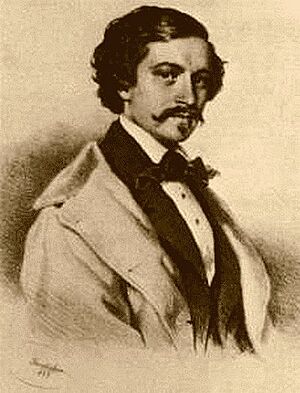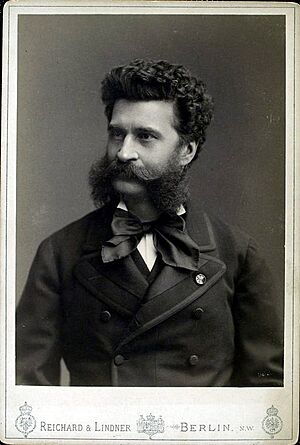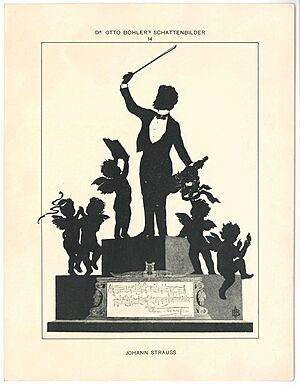Johann Strauss II facts for kids
Quick facts for kids
Johann Strauss II
|
|
|---|---|
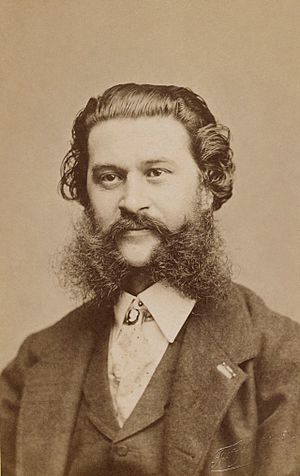 |
|
| Born | 25 October 1825 |
| Died | 3 June 1899 (aged 73) Vienna, Austria-Hungary
|
| Resting place | Vienna Central Cemetery |
| Occupation | Composer |
| Spouse(s) |
Henrietta Treffz
(m. 1862; died 1878)Angelika Dittrich
(m. 1878; div. 1882)Adele Deutsch
(m. 1887) |
| Parents |
|
| Signature | |
Johann Strauss II (born October 25, 1825 – died June 3, 1899) was an amazing Austrian composer and violinist. He was famous for his light music, especially dance music like waltzes and polkas, and also for his operettas.
He wrote over 500 pieces of dance music, including waltzes, polkas, and quadrilles. He also composed several operettas and a ballet. During his lifetime, people called him "The Waltz King." He made the waltz dance super popular in Vienna in the 1800s.
Some of his most famous works include "The Blue Danube" waltz, "Kaiser-Walzer" (Emperor Waltz), "Tales from the Vienna Woods", and the "Tritsch-Tratsch-Polka". His operettas Die Fledermaus and Der Zigeunerbaron are also very well known.
Johann Strauss II was the son of Johann Strauss I, who was also a composer. His two younger brothers, Josef and Eduard Strauss, also became composers of light music. However, they were never as famous as their older brother.
Contents
Early Life of a Music King
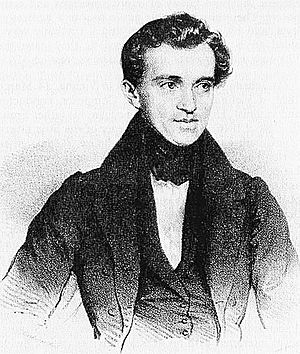
Johann Strauss II was born on October 25, 1825, in a town near Vienna, Austria. His father, Johann Strauss I, was a famous composer. But his father didn't want Johann II to become a musician. He wanted him to be a banker instead!
Despite his father's wishes, young Johann secretly learned to play the violin. His teacher was the first violinist in his father's orchestra, Franz Amon. One day, his father found him practicing the violin and was very angry.
It seems his father wanted to protect him from the tough life of a musician. But when his father left the family, Johann's mother supported his dream. This allowed Johann to focus completely on becoming a composer.
Johann then studied music with teachers like Professor Joachim Hoffmann and Joseph Drechsler. They helped him learn about counterpoint and harmony, which are important parts of music theory. He even wrote a religious song called Tu qui regis totum orbem in 1844.
Starting a Music Career
Johann Strauss I was very powerful in the music world of Vienna. Many places were afraid to hire Johann II because they didn't want to upset his famous father. But Johann II managed to convince Dommayer's Casino in Vienna to let him perform.
His father was so angry that he refused to ever play at Dommayer's Casino again. This was a place where he had performed many times before.
Johann II made his first big performance at Dommayer's in October 1844. He played some of his first songs, like the waltzes "Sinngedichte" and "Gunstwerber", and the polka "Herzenslust". Critics and newspapers loved his music! One critic wrote that Johann's name would live on through his son.
Even with this great start, Johann found it hard at first. But he soon became popular by performing in other cities. He even got an important job as "Kapellmeister of the 2nd Vienna Citizen's Regiment." This job had been empty since the death of another famous composer, Joseph Lanner.
Vienna faced big changes during the revolutions of 1848 in the Austrian Empire. Johann II chose to support the revolutionaries. This decision caused him some trouble. The Austrian royal family twice refused to give him the special job of KK Hofballmusikdirektor. This job was first created for his father because of his musical talents.
Johann II was even arrested for publicly playing "La Marseillaise", a revolutionary song. But he was later found innocent. His father, Johann I, stayed loyal to the monarchy. He wrote his famous "Radetzky March" for the emperor's army.
When his father died in 1849, Johann II combined both their orchestras. He then went on more tours. He also wrote patriotic marches for Emperor Franz Josef I. This was probably to show his loyalty to the new ruler.
Becoming a Star Composer
Johann Strauss II eventually became even more famous than his father. He was one of the most popular waltz composers of his time. He toured all over Austria, Poland, and Germany with his orchestra. In 1863, he finally got the job of KK Hofballmusikdirektor (Music Director of the Royal Court Balls), after being turned down many times.
In 1853, all the hard work made Johann very tired. He had a nervous breakdown. So, he took a seven-week break in the countryside. His younger brother, Josef, who was an engineer, was asked to lead Johann's orchestra for a while.
In 1855, Johann accepted an offer to play in Russia. He performed there every year until 1865. In 1862, his youngest brother, Eduard Strauss, also joined the Strauss orchestra as a conductor. Eduard and Josef led the orchestra together until 1870.
Later, in the 1870s, Johann Strauss and his orchestra toured the United States. He even led a huge "Monster Concert" in Boston with over 1000 performers! He played his "Blue Danube" waltz and other pieces, and everyone loved it.
During his visit to America, many fans wanted a lock of his hair as a souvenir. Johann's helper, his valet, had a clever idea. He clipped hair from Johann's black Newfoundland dog and gave it to the fans! But soon, they worried the dog would become bald because so many people wanted "authentic Strauss hair."
His Family Life
Johann Strauss married a singer named Henrietta Treffz in 1862. They were together until she passed away in 1878. Just six weeks after her death, Strauss married an actress named Angelika Dittrich.
However, Angelika was not very interested in his music. They had many disagreements, and he decided to get a divorce.
Since the Roman Catholic Church did not allow him to divorce, Johann changed his religion and his nationality. In January 1887, he became a citizen of Saxe-Coburg-Gotha.
He found happiness with his third wife, Adele Deutsch. They married in August 1887. Adele encouraged him to compose again in his later years. This led to many famous pieces, like the operettas Der Zigeunerbaron and Waldmeister, and the waltzes "Kaiser-Walzer" and "Kaiser Jubiläum."
Friends and Rivals in Music
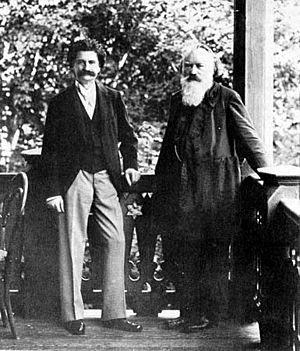
Johann Strauss was the most popular dance music composer in the late 1800s. But he still had competition! Composers like Carl Michael Ziehrer and Émile Waldteufel were also very good. Jacques Offenbach, a German operetta composer, was also a challenge for Strauss in the world of operettas.
Other famous composers admired Strauss. Richard Wagner once said he loved the waltz "Wein, Weib und Gesang" (Wine, Women and Song). Richard Strauss (who was not related to Johann) said, "How could I forget the laughing genius of Vienna?" when he wrote his own waltzes.
Johannes Brahms was a close friend of Johann Strauss. Strauss even dedicated his waltz "Seid umschlungen, Millionen!" ("Be Embraced, You Millions!") to Brahms. There's a famous story: Strauss's wife, Adele, asked Brahms to sign her fan. Usually, composers would write a few notes of their own famous music. But Brahms wrote a few notes from the "Blue Danube" and then added: "Unfortunately, NOT by Johannes Brahms." This showed his admiration for Strauss's work.
His Stage Works
Strauss's most famous operettas are Die Fledermaus, Eine Nacht in Venedig, and Der Zigeunerbaron. Many dance pieces that are still popular today came from these operettas. Examples include "Cagliostro-Walzer" and "Rosen aus dem Süden" Walzer.
Strauss also wrote one opera, Ritter Pázmán. He was working on a ballet called Aschenbrödel when he passed away in 1899.
Death and Lasting Music
Johann Strauss II was diagnosed with a lung illness. He died in Vienna on June 3, 1899, at the age of 73. He was buried in the Zentralfriedhof cemetery.
Thanks to the efforts of Clemens Krauss, Strauss's music is now played every year at the famous Vienna New Year's Concert. Many great conductors, like Willi Boskovsky and Herbert von Karajan, have performed his music. The Wiener Johann Strauss Orchester, formed in 1966, also honors the Strauss family's touring orchestras. In 1987, Dutch violinist and conductor André Rieu also created a Johann Strauss Orchestra.
Sadly, Eduard Strauss, Johann's brother, closed the Strauss Orchestra in 1901. He even sold the instruments. Many of the original music scores by the Strauss family were destroyed by Eduard in 1907. This was because he and his brother Josef had made a promise that whoever lived longer would destroy their works. They wanted to prevent other composers from claiming their music.
Today, two museums in Vienna are dedicated to Johann Strauss II. His home in Praterstrasse is now part of the Vienna Museum. The Strauss Museum tells the story of the whole Strauss family, with a special focus on Johann Strauss II.
Strauss in Movies and TV
The lives of the Strauss family members have been shown in several movies and TV shows. These include The Great Waltz (1938), which was remade in 1972. Other shows are The Strauss Family (1972), The Strauss Dynasty (1991), and Strauss, the King of 3/4 Time (1995). Many other films have used his wonderful music.
Even famous director Alfred Hitchcock made a movie about Strauss in 1934 called Waltzes from Vienna. After visiting Vienna, Walt Disney was inspired to create four movies. One of them was The Waltz King, a story about Strauss, which aired in the U.S. in 1963.
Works
Images for kids
-
His father, Johann Strauss I, in an etching from 1835
-
Strauss and Johannes Brahms photographed in Vienna
See also
 In Spanish: Johann Strauss (hijo) para niños
In Spanish: Johann Strauss (hijo) para niños


